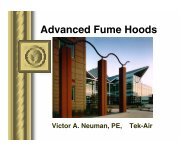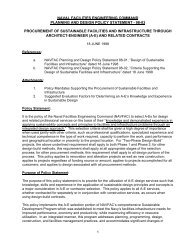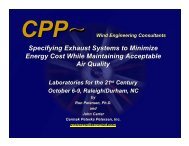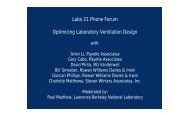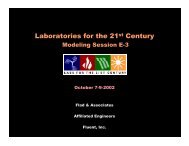manifolding laboratory exhaust systems - Lawrence Berkeley ...
manifolding laboratory exhaust systems - Lawrence Berkeley ...
manifolding laboratory exhaust systems - Lawrence Berkeley ...
Create successful ePaper yourself
Turn your PDF publications into a flip-book with our unique Google optimized e-Paper software.
L a b o r a t o r i e s f o r t h e 2 1 s t C e n t u r y :B e s t P r a c t i c e G u i d eManifolding Laboratory Exhaust SystemsI n t r o d u c t i o n : W h y M a n i f o l d ?Manifolding <strong>laboratory</strong> <strong>exhaust</strong> in <strong>laboratory</strong> buildingsprovides substantial energy and first-cost savingsopportunities when compared to separately ducted, multiple<strong>exhaust</strong> fans. A manifolded system also offers a numberof benefits, including:• Increased fume dilution• Enhanced personnel safety• Augmented redundancy• Improved design flexibility• Probable energy recoveryExperience has shown that during <strong>laboratory</strong> retrofitprojects, manifolded <strong>exhaust</strong> <strong>systems</strong> reduce constructioncosts and help avoid operational disruptions.This best practice guide is one in a series created bythe Laboratories for the 21 st Century (“Labs21”) program,a joint program of the U.S. Environmental ProtectionAgency and U.S. Department of Energy. Geared towardsarchitects, engineers, and facilities managers, these guidesprovide information about technologies and practices touse in the design, construction, and operation of safe, sustainable,high-performance laboratories.E n e r g y E f f i c i e n cy a n d M a n i f o l d e dE x h a u s tA basic, manifolded <strong>exhaust</strong> system, with a primaryfan and a backup unit in a common duct system, hashigher energy efficiency than multiple, dedicated fansworking independently. Manifolded <strong>exhaust</strong> <strong>systems</strong>save energy in four ways:1. Reduces fan power, in part due to less pressure dropin duct work.2. Provides an adjustable airflow system that can modulateenergy needs in response to a varying requirement.3. Requires less energy to disperse <strong>exhaust</strong> plumes dueto increased dilution and momentum of effluent.4. Increases energy recovery opportunities.Even greater efficiency can be realized over a basicmanifolded arrangement when advanced design practicesare used, including variable air volume fume hoods,multiple fans, and variable speed drives, which will becovered later in this guide and in referenced case studies.Fa n Po w e r R e d u c t i o nManifolded <strong>exhaust</strong> <strong>systems</strong> reduce the number offans and the ductwork needed when compared to individualfume hood <strong>exhaust</strong> <strong>systems</strong>. Therefore, less ener-United StatesEnvironmentalProtection AgencyU.S. Department of EnergyEnergy Efficiency and Renewable EnergyFederal Energy Management Program
L A B S F O R T H E 2 1 S T C E N T U R Y gy is used to move the <strong>exhaust</strong> air, due toconsolidation of numerous small fans into alarger and more efficient fan, and the reductionof ductwork pressure drop with largerdimension ductwork. See Labs21 Best PracticeGuide, Low-Pressure-Drop HVAC Design forLaboratories.A d j u s t a b l e A i r f l o wA manifolded <strong>exhaust</strong> system can bedesigned to accommodate varying fume hoodairflow. Since it is unlikely that all hoods willbe fully operational at one time, the inherentflexibility of a manifolded <strong>exhaust</strong> systemallows it to adjust its airflow rate accordinglyto save energy. This concept, also known as“diversity,” can also be applied to sizing themanifolded <strong>exhaust</strong> system, to reduce manifoldsize and initial costs. However, caution isadvised when considering a diversity factor,since a variety of issues needs to be considered,including future <strong>laboratory</strong> “growth.”Advantages of Manifolding Lab ExhaustFume DilutionIncreased internal dilution, with respect to the building’s ductworksystem, and enhanced external dilution, with respect to the building’senvelope, are advantages of manifolded fume hood <strong>systems</strong>. Achemical spill or odor generated in one hood is diluted by the combinedflow of all of the hoods, reducing concentration before reachingthe <strong>exhaust</strong> fan outlet. Additionally, when multiple fume hood<strong>exhaust</strong>s are mixed with general room <strong>exhaust</strong>, increased internaldilution of the <strong>exhaust</strong> stream is achieved. Combining contaminated<strong>exhaust</strong> air from each floor of a multistory building in a header ductserving multiple labs will increase dilution even further.Personnel SafetySafety of <strong>laboratory</strong> personnel can be increased when <strong>laboratory</strong><strong>exhaust</strong>s are manifolded. A manifolded design can readily includebuilt-in fan redundancy. Fan redundancy can automatically providebackup to maintain <strong>exhaust</strong> flow. By eliminating multiple <strong>laboratory</strong><strong>exhaust</strong> <strong>systems</strong>, maintenance personnel will spend less time on alab’s roof or in a mechanical space, thus minimizing exposure to hazardouschemicals from the serviced system and adjacent <strong>systems</strong>.E x h a u s t P l u m e D i s p e r s i o nManifolded <strong>exhaust</strong> <strong>systems</strong> haveincreased dilution, making <strong>exhaust</strong> streamsless hazardous. In addition, combiningnumerous hood <strong>exhaust</strong>s increases themomentum of this more dilute stream.Consequently, a manifolded <strong>exhaust</strong> stack dispersesa less hazardous stream into a plumemore effectively than a single-fan-per-hoodarrangement. See Labs21 Best Practice Guide,Modeling Exhaust Dispersion.E n e r g y R e c o v e r y O p p o r t u n i t i e sA manifolded <strong>exhaust</strong> system maximizesthe opportunity to recover energy containedin the conditioned air stream that is being<strong>exhaust</strong>ed from the laboratories. There arenumerous design and operational challengeswith recovering this energy, including: devicecorrosion, added air- system pressure drops,increased maintenance costs, operationaldurability, and control complexity, to name afew. Still, depending on the lab’s geographicallocation, <strong>exhaust</strong>-stream energy recovery, inthe form of both heating and cooling energy,can be worth the design challenges and maintenanceissues. See Labs21 Best Practice Guide,Energy Recovery for Ventilation Air inLaboratories.First-Cost SavingsManifolded <strong>exhaust</strong> <strong>systems</strong> can be less costly than individual <strong>systems</strong>due to less material and installation labor. Fewer fan ducts,ceiling and roof penetrations, electrical connections, and <strong>exhaust</strong>terminals typically yield a smaller first-cost capital investment.Individual, nonmanifolded <strong>systems</strong> require a larger “footprint” forthe same hood count and airflow volume. Increased shaft space forductwork will require a tradeoff in lab square footage. Since a <strong>laboratory</strong>building’s <strong>exhaust</strong> system must be operational at all times,a connection to an emergency power source is usually provided.A manifolded <strong>exhaust</strong> system is less costly to connect to an emergencypower source than numerous individual <strong>exhaust</strong>s fans. Inaddition, fewer fans lead to a Building Automation System (BAS), firealarm and smoke control system simplifications, and cost savings.Design FlexibilityModern <strong>laboratory</strong> facilities should have the ability to respond tochanges in research, technology, and personnel needs. Manifoldedfume hood <strong>exhaust</strong> <strong>systems</strong>, with their inherent flexibility, can helpmodern labs accommodate these changes. Many possibilities existfor adjusting and expanding manifolded <strong>systems</strong> without affectinga building structure. For example, hoods can usually be moved oradded with only minor changes in the HVAC system. When modifyinga <strong>laboratory</strong> space, tapping into the manifolded <strong>exhaust</strong> duct orplenum uses significantly less energy than a dedicated <strong>exhaust</strong> fan.Redundant fans allow maintenance operations to proceed withoutimpacting <strong>laboratory</strong> operations, so maintenance costs are reduced.The fan system capacity may be increased many times without disrupting<strong>laboratory</strong> operations.
L A B S F O R T H E 2 1 S T C E N T U R YB a s i c M a n i f o l d D e s i g nI n i t i a l C o n s i d e r a t i o n sDespite the considerable benefits <strong>laboratory</strong> <strong>exhaust</strong><strong>manifolding</strong> can provide, a lab’s design parameters willdetermine whether <strong>manifolding</strong> is appropriate. For example,while multiple <strong>exhaust</strong> fans effectively dilute hazardousfume hood <strong>exhaust</strong>, individual <strong>exhaust</strong> <strong>systems</strong> areusually more applicable in single-story buildings thathave a small number of widely separated standard fumehoods. In the latter scenario, an extended ductwork to amanifolded <strong>exhaust</strong> system may not be economically justifiable.Otherwise, the use of individual fume hood<strong>exhaust</strong> <strong>systems</strong> should be limited to special processesand hoods with pertinent, restrictive codes and regulations,e.g., perchloric acid fume hoods. When contemplatinga manifolded <strong>exhaust</strong> system, consider the followingfour topics:E x h a u s t C o m p a t i b i l i t yPerchloric acid and radioisotope hoods and biologicalsafety cabinets are segregated from general chemical<strong>exhaust</strong> due to incompatibility or special operating conditions,which may necessitate one hood per dedicated setof fans (standard for perchloric acid), or one type of hoodper dedicated set of fans (e.g., all radioisotope hoods manifoldedtogether). Biological safety cabinets (BSCs) used inBiosafety Level 1 (BL1) or Level 2 (BL2) work or just tissue-culturework can be manifolded with chemical fumehoods and lab general <strong>exhaust</strong>s. Biosafety Level 3 and 4(BL3 and BL4) labs and select “agent” labs that work withhighly infectious or toxic agents are prohibited from <strong>manifolding</strong>.F u m e H o o d N u m b e r a n d L o c a t i o nThe larger the number of fume hoods, the greater theoperating and installation economy that can be realizedfrom a manifolded system.R e q u i r e d F l e x i b i l i t yIf more hoods may be added or relocated in thefuture, then an appropriately sized manifold system willprovide the greatest degree of flexibility. See sidebar,“Advantages of Manifolding Lab Exhaust,” for moreinformation.C o d e s a n d S t a n d a r d sA manifolded fume hood <strong>exhaust</strong> system based onbest-practice safety and engineering principles needs tobe specified by the designer. Therefore, applicable codesand relevant standards should be reviewed, and designsshould be made in compliance with them. Note that forevery facility, “the authority having jurisdiction” canadopt a “standard(s)” as a “code.” Therefore, any standard,such as those listed below, can have “the force oflaw,” when so stipulated by “the authority.”During schematic design, the <strong>laboratory</strong> user orresearch group needs to provide the designer with a completelist of chemicals that are currently in use or will beused in the laboratories. This will assist in the selection ofappropriate <strong>exhaust</strong> system materials based on code complianceand compatibility with chemicals or agents to beused (and anticipated for future use) in the labs. If particulatesare present in the <strong>exhaust</strong>, sufficient transportvelocities in accordance with codes and adopted standardsmust be maintained in the ducts at all times.Codes• International Code Council (ICC), InternationalMechanical Code (IMC), Section 510. Stipulationsin this code do not preclude <strong>manifolding</strong> fume hood<strong>exhaust</strong>s so long as concerns for proper chemical compatibilityand mixing are met.• From the IMC, Section 502.10: “Exhaust ducts penetratingfire barrier assemblies shall be contained in a shaftof equivalent fire-resistive construction.”• If a lab is IBC “Group H-5,” then emergency poweris required for HPM <strong>exhaust</strong> ventilation <strong>systems</strong> perSection 415.9.10. The <strong>exhaust</strong> ventilation system isallowed to operate at not less than one-half the normalfan speed on emergency power where it is demonstratedthat the level of <strong>exhaust</strong> will maintain a safeatmosphere.• Check with your authority having jurisdiction overcode compliance. Some standards may have beenadopted by this authority as part of code requirements.(See “Standards,” below.)Standards• OSHA 29 CFR 1910.1450, “Occupational Exposure toHazardous Chemicals in Laboratories.”• NFPA 45-2004, Chapter 6, “Laboratory VentilatingSystems and Hood Requirements.”• ANSI/AIHA Z9.5, “American National Standardfor Laboratory Ventilation,” American NationalStandards Institute, Inc./American Industrial HygieneAssociation, ANSI/AIHA Z9.5, 2003.• Industrial Ventilation: A Manual of RecommendedPractice — 24th Edition. The American Conference ofGovernmental Industrial Hygienists, Inc. (ACGIH),eds. Cincinnati, OH. ISBN: 1-882417-42-9, 2001.
L A B S F O R T H E 2 1 S T C E N T U R Y B a s i c M a n i f o l d C o n f i g u r a t i o nTypically considered a standard design approach,Figure 1 shows a “basic” manifold configuration that connectsconstant volume (CV) fume hoods into a commonduct. Depending on the number of hoods in a lab spaceand the desired air change rate per hour (ACH), sufficientair may be <strong>exhaust</strong>ed through the CV hoods to satisfy theACH required. If not, a “general” <strong>exhaust</strong> would alsoneed to be tapped into the manifold ductwork.Labs with operations involving low-hazard chemicalscan be combined into common manifolds. Lab fumehoods using incompatible chemicals or other agents mustnot be manifolded without careful consideration of thequantity, types, and concentrations of agents that may bepresent. In all cases, see ANSI Z9.5, Section 5.3.2.1, forfurther discussion.RoofFigure Simple 1. Simple Centralized centralized <strong>exhaust</strong> Exhaust system. SystemTw o Fa n sCommon Exhaust Fanswith Single Exhaust StackFanFanIn a basic manifolded <strong>exhaust</strong> system configuration,two fans are connected to a common plenum to provide<strong>exhaust</strong> capacity: one fan is the primary or “lead” fan, andanother fan is the backup or “lag” fan to the primary. Inthis basic design, each fan’s capacity is equal to the maximumtotal <strong>exhaust</strong> requirement of the connected labs,with all hoods and equipment in use. The active fan operatesat a constant full speed to provide both required<strong>exhaust</strong> flow and a resulting stack exit velocity. Thus, amanifolded <strong>exhaust</strong> system mitigates the problem of a singlefan-per-hood failure, since backup capacity is readilyavailable for the connected hoods. In addition, fan inspectionand critical maintenance can be accomplished withoutshutting down the entire system.Fa n Ty p e sCentrifugal fans have efficient flow and pressurecharacteristics that are most often used in a manifolded<strong>exhaust</strong> system. Specialized axial-type <strong>exhaust</strong> fans areavailable for constant or variable air volume manifolded<strong>exhaust</strong> <strong>systems</strong> (discussed below). These fans aredesigned to move large amounts of ambient air into the<strong>exhaust</strong> plume as it is discharged from their stacks at ahigh upward velocity. The induced ambient air providesadditional dilution. The high plume velocity reduces thetendency for wind to push the <strong>exhaust</strong> back downtoward the building. However, these specializedinduced-air fans require higher energy use, since theyflow larger amounts of air in order to increase exit plumevelocity.D u c t w o r k a n d S t a c kManifold ductwork can be arranged to serve all orspecific groupings of laboratories and their fume hoods,typically on a particular floor or in a wing of a building.One large centralized <strong>exhaust</strong> backbone plenum servingthe total <strong>exhaust</strong> needs of a <strong>laboratory</strong> building helpsmaximize the energy benefit of a manifolded <strong>exhaust</strong> system.Manifolded <strong>exhaust</strong> <strong>systems</strong> may use horizontal orvertical <strong>exhaust</strong> headers, or a combination of the two.When designing the ductwork layout, attention shouldbe given to potential “system effects” that unnecessarilyincrease turbulence and pressure drop, which results inhigher fan energy use. Ductwork should be as straight aspossible, with minimum elbows. As a matter of due diligence,the manifold <strong>exhaust</strong> ductwork system should betested for its overall leakage rate, and the responsibleengineer should document these test results in the building’spermanent records.Usually, a manifolded system’s stack can be moreconveniently located away from <strong>laboratory</strong> intakes tominimize potential re-entrainment. To the extent possibleafforded by the facility’s layout, it is advised to cluster orgroup the <strong>exhaust</strong> stacks to enhance plume dispersion.D a m p e r sDampers must be used in manifolded <strong>exhaust</strong> <strong>systems</strong>to provide fan isolation. Manifolds with outletgravity-style backdraft dampers are a minimum-designnecessity to prevent reverse-flow short circuits throughidle (lag) manifolded fans. Damper configuration, material,actuator type, end switches, and seals are some of thenecessary design considerations. Monitoring the manifold’sdamper positions with the <strong>laboratory</strong> facility’sbuilding automation system (BAS) is recommended.
L A B S F O R T H E 2 1 S T C E N T U R YG o o d M a n i f o l d D e s i g n P r a c t i c eWhen compared to the basic constant-volume (CV)manifolded <strong>exhaust</strong> system presented above, energyefficiencyimprovement in the range of 30 percent can beachieved with “good” design practice. The following three“good practice” enhancements to the basic design approachprovide pragmatic energy-use reductions without excessiveexpenses or design complications (see Figure 2):1. Exhaust less conditioned air. Reduce conditioned air<strong>exhaust</strong>ed from a building by using variable air volume(VAV) <strong>systems</strong>, including VAV fume hoods and abypass damper.2. Modulate fan speed. Decrease <strong>exhaust</strong> fan powerby using variable speed drives (VSDs) to modulate<strong>exhaust</strong> fan speed.3. Set back duct static pressure. Reduce <strong>exhaust</strong> fanenergy use by lowering manifold duct static pressureduring off-hours operation (static pressure reset).C o n s i d e r a t i o n sWhen VAV hoods are connected to a manifolded <strong>laboratory</strong><strong>exhaust</strong> system, the manifolded system experienceschanging airflow volume caused by varying fume hoodsash positions. This good-practice manifold configurationuses an inlet, or bypass damper, located in the exteriorcentral <strong>exhaust</strong> plenum. Modulating the bypass damperprovides a constant <strong>exhaust</strong> duct static pressure, while theconstant fan speed provides a constant stack exit velocity.This constant pressure control approach does not save<strong>exhaust</strong> fan energy, but it does reduce the amount of<strong>exhaust</strong>ed conditioned air from the facility, while providingthe required stack exit velocity. A good manifoldedsystem design also has a motorized isolation damper atthe inlet of each fan connected to the centralized plenum.M o d u l a t e Fa n S p e e dS u m m a r y• Add variable speed drives (VSDs) to the <strong>exhaust</strong> fansto further reduce energy use. LabGeneralExhaust(Typical)DamperRoofFanFanOutsideAirBypassDamperStaticPressureController• Modulate bypass damper to maintain sufficient<strong>exhaust</strong> volume in response to hood operations; asmore hoods are opened, the bypass damper modulatesto a closed position.• Operate <strong>exhaust</strong> fans at a reduced speed, maintainingthe minimum required stack velocity until the bypassdamper is fully closed.• Increase <strong>exhaust</strong> fan speed to provide necessary volumeflow when the bypass damper is fully closed andmore hoods are opened.Figure 2. Good <strong>manifolding</strong> design practice.StaticPressureSensor• Modulate the bypass damper until it is fully open tomaintain minimum stack exit velocity when all fumehood sashes are in a “closed” position, e.g., off-hoursoperation.C o n s i d e r a t i o n sE x h a u s t L e s s C o n d i t i o n e d A i rS u m m a r y• Use VAV lab hoods.• Track changing VAV hood <strong>exhaust</strong> volume with abypass damper.• Ensure that lab general <strong>exhaust</strong>, plenum bypass damper,static pressure sensor(s), and controls maintain theminimum lab air change rate and desired directionalairflow.• Operate <strong>exhaust</strong> fans at a sufficient speed to meet exitvelocity requirements.The design of a manifold with a bypass damper fortracking changing manifold volume can be enhanced byadding variable speed drives (VSDs) to the <strong>exhaust</strong> fans.Varying the speed of the primary <strong>exhaust</strong> fans with VSDssaves more energy than only using a bypass damper.First, the design must provide adequate stack dischargevelocity for an “absolute minimum” airflow thatresults when all fume hood sashes are in their closed(minimum) position. This velocity requirement is providedwith the manifold bypass damper (noted above) in itsfull open position. Second, as increased <strong>exhaust</strong> capacityis required (due to an increased open sash area), thebypass damper is eventually modulated to a fully closed
L A B S F O R T H E 2 1 S T C E N T U R Y position by the control system. Typically, this airflow volumeis considered a “most-likely minimum” airflow that ispredicted by a chosen fume hood “diversity factor.” Third,airflow volume greater than the most-likely minimum isprovided by continuously adjusting fan speed with theVSD in response to duct static pressure changes in themanifold plenum caused by more fume hood sashes beingopened. Finally, with maximum volume demand on thesystem, the primary fan operates at maximum speed withall hood sashes open.When using variable speed drives, it is important tochoose a fan type that has flow characteristics well suitedfor the airflow volume ranges resulting from fume hoodactivity. Additionally, these multiple fan arrangementsprovide redundancy in the system, for safety.S e t B a c k D u c t S t a t i c P r e s s u r eS u m m a r y• Reset the static pressure operating point for the manifoldedsystem with the building automation system (BAS).C o n s i d e r a t i o n sEnergy-efficient control of a manifolded <strong>exhaust</strong> systemis accomplished with direct digital control (DDC) thatis part of the facility’s BAS. Monitor duct static pressure inat least two locations by placing one static pressure sensorin the <strong>exhaust</strong> plenum, just after the entry of the main<strong>exhaust</strong> inlet duct; and placing the other sensor in one ofthe <strong>exhaust</strong> system duct branches at the location where thestatic pressure is anticipated to be at the lowest (the leastnegative) value. Typically, this will be in the longest<strong>exhaust</strong> system branch duct, at the farthest end from the<strong>exhaust</strong> plenum; however, pressure sensor quantity andlocation(s) are highly system-dependent.The following DDC input information and output controlsare recommended:Input Information• Exhaust stack discharge air velocity: Maintain the<strong>exhaust</strong> stack discharge air velocity above the requiredminimum.• Fan speed input: Verify variable speed drive operation.• Fan failure/status: Automatic/bypass start of standby<strong>exhaust</strong> fan(s).• Manifold duct static pressure: Used for controlling fanspeed and starting standby fan(s).• Isolation damper position end switches: Verify fullopening or closure of damper.• Bypass damper position: Verify damper position.Output Control• Start/stop fan: Initiate fan operation through variablespeed drive (VSD).• Fan speed output: Modulate VSD control of fan speedto maintain the duct static pressure set point.• Isolation damper operation: Initiate opening/closingof damper.• Bypass damper operation: Continuous positioning ofdamper to maintain the duct static pressure set point.B e t t e r M a n i f o l d D e s i g n P r a c t i c eAdditional energy-efficiency improvements in therange of a 50 percent reduction compared to a CV systemcan be realized when “better” design practice is addedto the good-design practice for manifolded <strong>exhaust</strong> <strong>systems</strong>,presented above. The following three good-designpracticeenhancements substantively reduce energy use(see Figure 3):1. Stepped fan operation. Reduce fan power by steppingoperation of constant volume fans.2. Modulate fan speed. Decrease <strong>exhaust</strong> fan powerby using variable speed drives (VSDs) to modulate<strong>exhaust</strong> fan speed.3. Evaluate plume dispersion. Diminish energy neededfor plume generation by performing dispersionanalyses.LabGeneralExhaust(Typical)DamperRoofFan (typical)Figure 3. Better <strong>manifolding</strong> design practice.StaticPressureand FanSpeedControllerOutsideAirBypassDamperStaticPressureSensor
L A B S F O R T H E 2 1 S T C E N T U R YS t e p p e d Fa n O p e r a t i o nS u m m a r y• Uses multiple fans and stacks connected to commonplenum.• Provides necessary stack exit velocity.• Uses less fan energy in smaller diameter stacks.• Requires isolation dampers, controls, and programmingto start/stop multiple, stepped fans.C o n s i d e r a t i o n sUsing a set of multiple <strong>exhaust</strong> fans provides greateroperational flexibility and increased redundancy than oneprimary fan. The number of fans connected to a manifold<strong>exhaust</strong> system is influenced by a variety of factors, including:• Total airflow volume• Diversity, i.e., the ratio of minimum to maximum flowor the percent of theoretical maximum flow• Required stack exit velocity• Hazard analysis• Effluent dispersion needsTherefore, a “better” design practice uses multiplefans sized for partial volume so the airflow can be steppedup or down by starting or stopping additional fans. A minimumof three <strong>exhaust</strong> fans — two primary and one standby— are used; more fans may be incorporated. In general,<strong>exhaust</strong> airflow volume is adjusted by individuallysequencing the fans connected to the manifold’s commonplenum. This approach reduces energy by <strong>exhaust</strong>ing lessair during low hood use. When using three constant-volumefans, each unit is sized to provide 50 percent of therequired maximum volume <strong>exhaust</strong> airflow. Therefore,with one fan operating, the manifold system can provideup to 50 percent of the maximum design capacity; withtwo fans operating, 100-percent capacity is provided. Thethird fan provides backup in the event of either primaryfan’s failure. Each of these constant-volume fans generatesthe required stack exit velocity.Better manifolded <strong>exhaust</strong> <strong>systems</strong> use high-quality,leakage-rated, motorized isolation dampers, betweenboth the inlet and outlet of each <strong>exhaust</strong> fan, which do notallow stack <strong>exhaust</strong> air of an operating fan to be drawnthrough a nonoperating fan.M o d u l a t e Fa n S p e e dS u m m a r y• Add VSDs to each <strong>exhaust</strong> fan (a minimum of three VSDs).• Operate two primary fans in parallel to maintain minimumrequired stack velocity.• Maintain minimum stack exit velocity with a bypassdamper when all fume hood sashes are in a “closed”position, e.g., off-hours operation.C o n s i d e r a t i o n sAs described above, a stepped operation of three<strong>exhaust</strong> fans, sized at 50 percent of maximum capacity,improves energy efficiency. However, building on thisapproach, increased efficiency can be realized by modulatingeach fan’s capacity with an associated VSD, thusproviding a variable-volume capability.As in the good-design approach, a modulatingbypass damper ensures that the required stack exit velocityis provided below a most-likely minimum airflowcondition (see Figure 3). When the most-likely minimumairflow through the manifold system is reached, i.e.,when the system “diversity” is reached, the bypassdamper will be fully closed. Increased volume flow,above the most-likely minimum, is provided by increasingthe speed of the primary fans, in parallel, with theirVSDs. In this way, compared to the good-design-practiceapproach, greater efficiency is achieved by operating twosmaller fans with smaller diameter <strong>exhaust</strong> stacks in parallelthan by operating one large fan with a larger diameterstack. In addition, in the event one primary fan fails,the other operating primary fan immediately speeds upto maintain the required volume airflow. The backup(standby) fan is then brought online gradually. Note thatmore than three fans can be used, but control and maintenancebecome increasingly complex and costly as morefans are added.E v a l u a t e P l u m e D i s p e r s i o nS u m m a r y• Evaluate stack exit velocity to a lower energy use thatensures safe and effective operation.C o n s i d e r a t i o n sThere is an associated energy cost to dispersing an<strong>exhaust</strong> stack’s plume. Within the manifolded <strong>exhaust</strong>system’s ductwork, combining many hood and general<strong>exhaust</strong>s increases effluent dilution. Therefore, a fundamentalbenefit of a manifolded system is a diluted effluentbeing expelled from its stack(s). By carefully studyingthis diluted plume’s dispersion, <strong>exhaust</strong> fan energy usecan be reduced. (See sidebar on “Benefits of ManifoldingFume Hood Exhausts — A Dispersion ModelingPerspective.” Also see Labs21 Best Practice Guide,Modeling Exhaust Dispersion.)
L A B S F O R T H E 2 1 S T C E N T U R Y When considering a stack exit velocity, it is recommendedthat plume dispersion calculations or atmosphericmodeling be performed to evaluate <strong>exhaust</strong>re-entrainment rather than to use a “design standard.”These evaluation techniques will account for the beneficialdilution and momentum provided by a manifoldedsystem, and will likely result in a lower stack exit velocity,thus saving <strong>exhaust</strong> fan energy.M a n i f o l d Pe r f o r m a n c e E x a m p l e sC a s e S t u d i e sM i n n e s o t a C o l l e g e R e t r o f i tA completed renovation project for a lab at MinnesotaCollege, a small private educational institution, provideda net reduction from 30 dedicated <strong>exhaust</strong> fans to sixarranged on three plenums. Each fan, sized for approximately67 percent of the full load, provides backup capacityand growth potential. This project demonstrated amanifolded lab <strong>exhaust</strong> system’s improved design flexibilityand increased fume dilution, while providing a substantialenergy reduction.G e n e n t e c h , I n c .The flexibility of manifolded <strong>exhaust</strong> <strong>systems</strong>enabled Genentech to promote its science and save energysimultaneously. By using VFD-driven fans in the <strong>exhaust</strong>manifold system, a quarter-million-sq-ft lab project hassaved approximately $100,000 in annual operating costswhen compared to a constant volume/air bypass manifoldeddesign. In another instance when even morehoods were needed on another manifolded <strong>exhaust</strong> systemthat would not accommodate larger <strong>exhaust</strong> fanmotors, disruptions to research activities were minimizedwhile lab hood sashes were changed sequentially fromoperating vertically to horizontally. Horizontal hoodsashes, sized to fit the science, reduced energy demandfrom 30 ten-foot hoods by a third.E n e r g y E v a l u a t i o n sN a t i o n a l R e n e w a b l e E n e r g y L a b o r a t o r y ( N R E L )The NREL Science and Technology Facility (S&TF)<strong>exhaust</strong>-air system incorporates six (20,000 cfm each) parallel<strong>exhaust</strong> fans, one of which is always available asbackup. The fans in the S&TF are staged according tobuilding <strong>exhaust</strong> needs, an improvement on the typicallab construction where all <strong>exhaust</strong> fans run 100 percent ofthe time at a constant speed, and pull in bypass air whenbuilding <strong>exhaust</strong> requirements are less than <strong>exhaust</strong>-fancapacity. A DOE2 energy analysis comparing the six-fandesign to three 50,000 cfm fans (with one always availableBenefits of Manifolded Fume HoodExhausts — A Dispersion ModelingPerspectiveOne of the benefits associated with manifolded<strong>exhaust</strong> <strong>systems</strong> is an increased momentum, resultingin improved plume rise of the discharged flow.For example, a 10,000 cfm <strong>exhaust</strong> will achieve aplume rise about three times greater than a 1,000cfm <strong>exhaust</strong> discharged at the same velocity, windconditions, and stack height. Increasing the distancethe plume rises above the emitting building is effectivein avoiding recirculation zones, and will result inimproved overall dispersion.A second benefit of <strong>manifolding</strong> is increased internaldilution of the combined <strong>exhaust</strong> stream. For a typicalworst-case scenario where a large release wouldoccur in one fume hood, the <strong>exhaust</strong> in a manifoldedsystem would be diluted “internally” prior to being dischargedto the atmosphere (i.e., contaminated <strong>exhaust</strong>is diluted by “clean” air in other fume hoods).The total dilution achieved by the <strong>exhaust</strong> stream at areceptor location (e.g., air intake, window) is the productof internal dilution (between the point of contaminationand point of discharge) and external dilution(between the stack top and the receptor). As the internaldilution of a system increases, less outdoor stack<strong>exhaust</strong> dilution will be needed. Therefore, savingsin energy costs and stack design requirements canbe achieved. In addition, a single stack for a central<strong>exhaust</strong> system will be easier to position to reduce theimpact on building air intakes than multiple individual<strong>exhaust</strong> stacks.Provided by Simona Besnea with RWDIas a backup), including stacks and dampers, determinedthat the six-fan design saved approximately $4,700 peryear in energy costs, and provided an eight-year simplepayback.C o n cl u s i o nA holistic, team-based approach is important whendetermining the design and appropriateness of a manifolded<strong>exhaust</strong> system. Design decisions regarding fantype, stack location, plenum configuration, ductworkdetails, controls, and screening <strong>systems</strong> need carefulattention to optimize the energy reductions inherentlyobtainable with a manifolded <strong>exhaust</strong> system.
L A B S F O R T H E 2 1 S T C E N T U R YArchitectural and mechanical designers may need to collaboratewith specialized consultants to perform dispersionstudies, re-entrainment analyses, and acousticalreviews. Developing the system’s control sequence, andconducting performance-based commissioning with experiencedprofessionals offer the best likelihood of achievingsuccess. Thorough training of maintenance personnel willensure efficient, long-term operation.R e f e r e n c e sAmerican Industrial Hygiene Association, “HazardousExhaust Systems in Research Laboratories that Involve‘Laboratory Scale’ Use of Chemicals,” position paper preparedby the AIHA Laboratory Health and SafetyCommittee, December 1, 2002.ANSI/AIHA Z9.5, “American National Standard forLaboratory Ventilation,” American National StandardsInstitute, Inc./American Industrial Hygiene Association,ANSI/AIHA Z9.5, 2003.American Society of Heating, Refrigeration, and Air-conditioningEngineers (ASHRAE), 2005 Fundamentals Handbook,Atlanta, GA: ASHRAE, 2005.ASHRAE Laboratory Design Guide, American Society ofHeating, Refrigerating, and Air-Conditioning Engineers,Atlanta, GA: 2001.Building Performance — Fume Hood Retrofits, Pacific Gas andElectric Energy Center, eds. San Francisco, CA: Pacific Gasand Electric, 1994.Charneux, R.M. and M. Eng, “Innovative LaboratorySystem,” ASHRAE Journal, vol. 43, no. 6, p. 48–50, June 2001.Crockett, J., “ISU2 Team Interacts for System Success,”Consulting-Specifying Engineer, September 1999.Dickenson, D., “Exhaust Ductwork: To Manifold or Not toManifold? Factors Governing the Choice of DedicatedFume Hood Exhaust Vs. Combined Exhaust,” The LabDesign Handbook, Chapter 7, Mechanical Systems byMichael Reagan, AIA, University Hospitals ResearchInstitute, 2003.Industrial Ventilation: A Manual of Recommended Practice —24th Edition, the American Conference of GovernmentalIndustrial Hygienists, Inc. (ACGIH), eds. Cincinnati, OH.ISBN: 1-882417-42-9, 2001Koenigsberg, J., “Should Your Laboratory Be Equippedwith a Hazardous Exhaust System?” R&D Magazine,Laboratory Design Newsletter, Volume 7, #13, March 2002.Laboratory Control and Safety Solutions Application Guide,Rev. 2, Landis and Gyr, eds. Buffalo Grove, IL: Landis andGyr Powers, Inc., 1994.McKew, A., “HVACR Designer Tips: Stack Exhaust,”Engineered Systems, September 1998.Nelson, N., “Chapter 6 — Energy Conservation,” Handbookof Facilities Planning, Vol. One, Laboratory Facilities. ISBN0-442-31852-9. Ruys, Theodorus, AIA, ed. New York: VanNostrand Reinhold, 1990.Neuman, V.A. and E. Sandru, “The Advantages ofManifolding Fume Hood Exhausts,” ASHRAE Transactions,Vol. 96, part 1, 357–360, 1 fig, refs., November 1990.Neuman, V.A. and W.H. Rousseau, “VAV for LaboratoryHoods — Design and Costs,” ASHRAE Transactions 1986,Vol. 92, Part 1A: 330–346, 9 figs, 6 tabs, 9 refs. 1986.Rydzewski, A.J., “Design Considerations of a LargeCentral Laboratory Exhaust,” ASHRAE Transactions:Symposia, Winter Meeting, Chicago, IL. CH-99-7-3, 1999.Wendes, H.C., “Variable Volume Fume Hood ExhaustSystems,” Lilburn, GA: Fairmont Press, 1990.
10L A B S F O R T H E 2 1 S T C E N T U R Y A c k n o w l e d g m e n t sA u t h o rGeoffrey C. Bell, P.E.<strong>Lawrence</strong> <strong>Berkeley</strong> National LaboratoryOne Cyclotron RoadM.S. 90-3111<strong>Berkeley</strong>, CA 94720Voice: 510-486-4626E-mail: gcbell@lbl.govC o n t r i b u t o r s a n d R e v i e w e r sSimona Besnea, P. Eng.Project EngineerRowan Williams Davies & Irwin Inc.Consulting Engineers & Scientists650 Woodlawn Road WestGuelph, Ontario, Canada N1K 1B8Phone: 519-823-1311 ext 2339Fax: 519-823-1316E-mail: www.rwdi.comLou DiBerardinisDirectorMassachusetts Institute of TechnologyEnvironment, Health, and Safety OfficeVoice: 617-253-9389E-mail: LouDiB@mit.eduPaul Mathew, Ph.D.<strong>Lawrence</strong> <strong>Berkeley</strong> National Laboratory901 D. Street SW, Suite 950Washington, DC 20024Voice: 202-646-7952Fax: 202-646-7800E-mail: pamathew@lbl.govVictor Neuman, P.E.LSW EngineersVoice: 619-865-8235E-mail: vneuman@lswsd.comGary Shamshoian, P.E.GenentechVoice: 650-225-7324E-mail: garysham@gene.comOtto Van Geet, P.E.National Renewable Energy LaboratoryPhone: 303-384-7369Fax: 303-384-7330E-mail: Otto_VanGeet@nrel.govFo r M o r e I n f o r m a t i o nO n L a b o r a t o r i e s f o r t h e 2 1 s t C e n t u r yDan Amon, P.E.National Energy ManagerU.S. Environmental Protection Agency1200 Pennsylvania Ave., N.W.Washington, DC 20460202-564-7509amon.dan@epa.govWill Lintner, P.E.Federal Energy Management ProgramU.S. Department of Energy1000 Independence Ave., S.W.Washington, DC 20585-0121202-586-3120william.lintner@ee.doe.govB e s t P r a c t i c e s G u i d e s o n t h e We bwww.labs21century.gov/toolkit/bp_guide.htmLaboratories for the 21st CenturyU.S. Environmental Protection AgencyOffice of Administration and Resources Managementwww.labs21century.govIn partnership with theU.S. Department of EnergyEnergy Efficiency and Renewable EnergyBringing you a prosperous future where energyis clean, abundant, reliable, and affordablewww.eere.energy.govPrepared at the <strong>Lawrence</strong> <strong>Berkeley</strong> National LaboratoryA DOE national <strong>laboratory</strong>DOE/GO-102005-April 2007Printed with a renewable-source ink on paper containing at least50% wastepaper, including 20% postconsumer waste





